Chinese Marriage Custom
- 格式:docx
- 大小:27.93 KB
- 文档页数:10
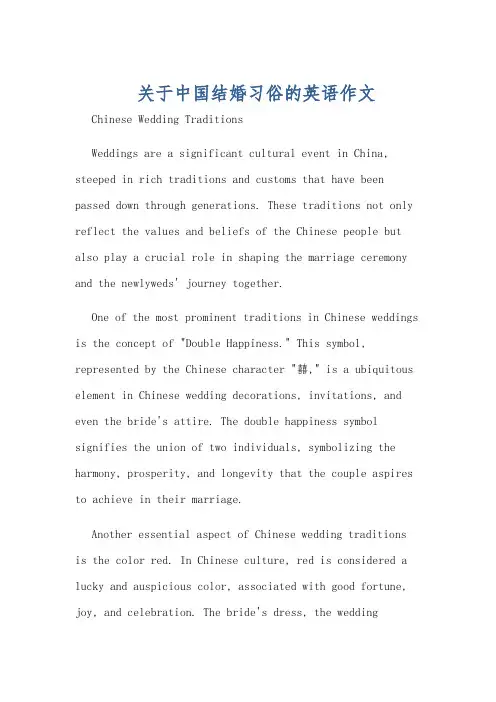
关于中国结婚习俗的英语作文Chinese Wedding TraditionsWeddings are a significant cultural event in China, steeped in rich traditions and customs that have been passed down through generations. These traditions not only reflect the values and beliefs of the Chinese people but also play a crucial role in shaping the marriage ceremony and the newlyweds' journey together.One of the most prominent traditions in Chinese weddings is the concept of "Double Happiness." This symbol, represented by the Chinese character "囍," is a ubiquitous element in Chinese wedding decorations, invitations, and even the bride's attire. The double happiness symbol signifies the union of two individuals, symbolizing the harmony, prosperity, and longevity that the couple aspires to achieve in their marriage.Another essential aspect of Chinese wedding traditions is the color red. In Chinese culture, red is considered a lucky and auspicious color, associated with good fortune, joy, and celebration. The bride's dress, the weddingdecorations, and even the traditional tea ceremony are often adorned with shades of red, creating a vibrant and festive atmosphere.The tea ceremony is a significant ritual in Chinese weddings, where the newlyweds pay respect to their elders and show their gratitude for the blessings and guidance they have received. During this ceremony, the couple serves tea to their parents, grandparents, and other senior family members, demonstrating their respect and filial piety, which are highly valued in Chinese culture.The exchange of gifts is another crucial element of Chinese wedding traditions. The bride's family typically presents the groom's family with a dowry, which may include jewelry, clothing, or household items. In return, the groom's family offers a betrothal gift, known as the "bride price," which serves as a symbol of their commitment and financial support for the newlyweds.The wedding procession, known as the "Guo Da Li," is a grand and elaborate event in Chinese weddings. The bride is typically carried in a decorated sedan chair or a vintage car, accompanied by a lively parade of family members,friends, and musicians. This procession not only showcases the couple's status and wealth but also celebrates the joyous occasion with the entire community.Another unique aspect of Chinese wedding traditions is the use of auspicious dates and times. The couple and their families often consult with a feng shui expert or a Chinese astrologer to determine the most favorable date and timefor the wedding ceremony, ensuring that the union is blessed with good fortune and harmony.In recent years, traditional Chinese wedding customs have evolved and adapted to modern times, with some couples incorporating both traditional and contemporary elements into their celebrations. However, the core values and beliefs that underpin these traditions remain deeply rooted in Chinese culture, serving as a testament to the rich heritage and the enduring significance of marriage in the lives of the Chinese people.中国结婚习俗婚礼在中国文化中是一个重要的事件,充满了丰富的传统和习俗,这些习俗代代相传。
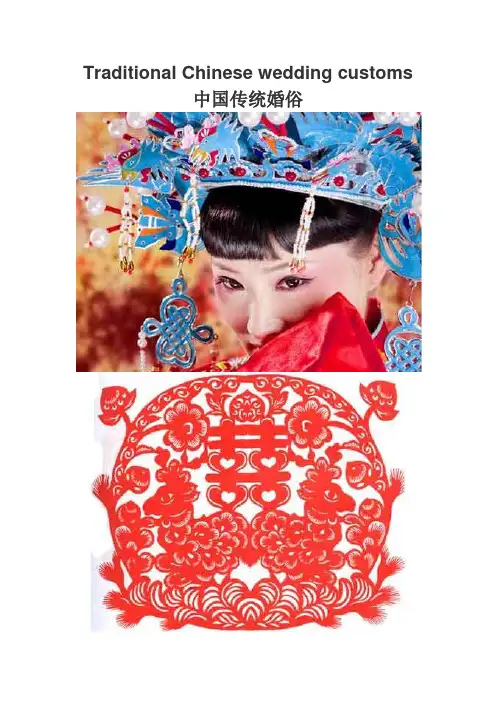
Traditional Chinese wedding customs中国传统婚俗Traditional Chinese wedding customs are considered as the foundation of rites in traditional Chinese culture. A wedding is usually a grand occasion with overly-elaborate formalities. There are eight major procedures of a wedding, including proposal making, birthday matching, marriage divination, betrothal gifts presenting, wedding date fixing, dowry urging, welcoming the bride to the wedding and performing the formal wedding ceremony.The procedure of birthday matching was the process in which the boy's family asked the matchmaker to go to the girl's family to enquire about her name and date of birth. Then, the boy's parents would send the girl's and their son's names and birthdates to a sorcerer or fortune teller for divining to see if the marriage between the two would be appropriate. The foretelling of the luck of the marriage was what was called "marriage divination".If according to Chinese astrology the couple was compatible and both families agreed to the marriage, the boy's family would then send betrothal gifts to the girl's family. The betrothal gifts mainly included clothes, jewelries, gold, silver and cash etc. In addition, a gilded silver coin bearing the word "qiu" (meaning "proposal") was among the gifts. The girl's family would send back another coin bearing the word "yun" (meaning "agreed") among their gifts presented in return. Thus, the marriage was confirmed.Then, the two families would make arrangements for the wedding. When everything was ready, the boy's family would invite a fortune teller to choose a wedding date believed to bring the most luck to the couple based on the Chinese calendar mythology. After the date was fixed, the boy's family would send someone to inform the girl's family of it, which was part of the procedure of fixing the wedding date.During the period between the wedding date settlement and welcoming the bride, the boy's family would customarily urge the girl's family to send her dowry in for bridal chamber decoration, otherwise the wedding could not be held on schedule. After being urged, the girl's family would begin to prepare the dowry, which would be sent to the boy's family on a chosen date. The amount and quality of the dowry would determine the girl's future status in her husband's family.Welcoming the bride to the wedding and performing the formal wedding ceremony would be conducted on the same day, which was the climax of the whole wedding procedures. On the wedding day, the bridegroom's family would welcome the bride to the wedding in a bridal sedan accompanied by a wedding procession. With firecrackers exploding and band playing, the precession was a noisy and joyous show. As soon as the bride arrived at the groom's home, the couple would perform formal bows. The rituals were also called "bowing to Heaven and Earth", which were conducted to gain approval of the marriage from gods, divinities,ancestors as well as from parents, older generations, relatives and neighbors in the mortal world.After the bowing rituals, the couple would enter the bridal chamber, followed by rituals like sitting on the bed, throwing happiness-embodying nuts and drinking the nuptial cup etc. After that, relatives and friends to the wedding would be treated to a wedding feast. Then, wedding guests, old and young, would play bridal chamber pranks and wouldn't leave till the dead of night. Thus, the wedding ceremony was finished. Traditional Chinese wedding customs have been around for thousands of years. They may vary from place to place and time to time, but have been holding an important position in the lives of Chinese people, causing a far-reaching impact on the way the Chinese lead their lives.中国是一个有56个民族的大国。
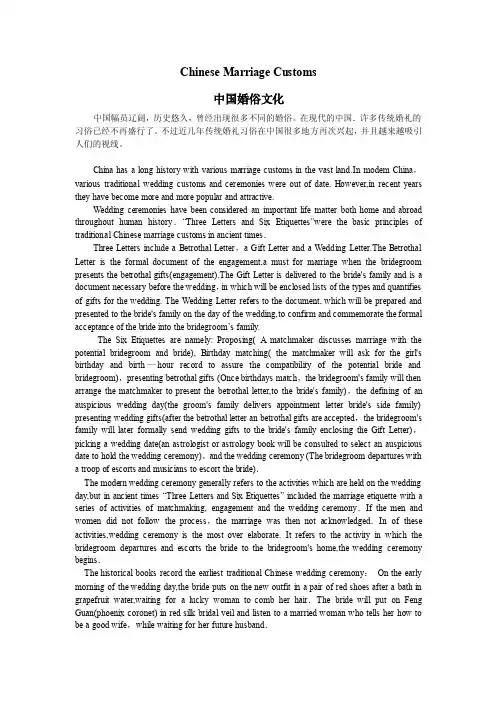
Chinese Marriage Customs中国婚俗文化中国幅员辽阔,历史悠久,曾经出现很多不同的婚俗。
在现代的中国.许多传统婚礼的习俗已经不再盛行了。
不过近几年传统婚礼习俗在中国很多地方再次兴起,并且越来越吸引人们的视线。
China has a long history with various marriage customs in the vast land.In modem China,various traditional wedding customs and ceremonies were out of date. However,in recent years they have become more and more popular and attractive.Wedding ceremonies have been considered an important life matter both home and abroad throughout human history.“Three Letters and Six Etiquettes”were the basic principles of traditional Chinese marriage customs in ancient times.Three Letters include a Betrothal Letter,a Gift Letter and a Wedding Letter.The Betrothal Letter is the formal document of the engagement,a must for marriage when the bridegroom presents the betrothal gifts(engagement).The Gift Letter is delivered to the bride's family and is a document necessary before the wedding,in which will be enclosed lists of the types and quantifies of gifts for the wedding. The Wedding Letter refers to the document, which will be prepared and presented to the bride's family on the day of the wedding,to confirm and commemorate the formal acceptance of the bride into the bridegroom’s family.The Six Etiquettes are namely: Proposing( A matchmaker discusses marriage with the potential bridegroom and bride), Birthday matching( the matchmaker will ask for the girl's birthday and birth—hour record to assure the compatibility of the potential bride and bridegroom),presenting betrothal gifts (Once birthdays match,the bridegroom's family will then arrange the matchmaker to present the betrothal letter,to the bride's family),the defining of an auspicious wedding day(the groom's family delivers appointment letter bride's side family) presenting wedding gifts(after the betrothal letter an betrothal gifts are accepted,the bridegroom's family will later formally send wedding gifts to the bride's family enclosing the Gift Letter),picking a wedding date(an astrologist or astrology book will be consulted to select an auspicious date to hold the wedding ceremony),and the wedding ceremony (The bridegroom departures with a troop of escorts and musicians to escort the bride).The modern wedding ceremony generally refers to the activities which are held on the wedding day,but in ancient times “Three Letters and Six Etiquettes” included the marriage etiquette with a series of activities of matchmaking, engagement and the wedding ceremony.If the men and women did not follow the process,the marriage was then not acknowledged.In of these activities,wedding ceremony is the most over elaborate. It refers to the activity in which the bridegroom departures and escorts the bride to the bridegroom's home,the wedding ceremony begins.The historical books record the earliest traditional Chinese wedding ceremony:On the early morning of the wedding day,the bride puts on the new outfit in a pair of red shoes after a bath in grapefruit water,waiting for a lucky woman to comb her hair.The bride will put on Feng Guan(phoenix coronet) in red silk bridal veil and listen to a married woman who tells her how to be a good wife,while waiting for her future husband.The fun is that when the groom comes to the door of the bride's,the bridesmaids and her sisters try not to let him in!The purpose is to let the bridegroom experience difficulties to enter the door.Usually the groom can overcome the difficulties with his wisdom and courage and the help of hisfriends.Then,the groom sings for the bride and finally he can see the bride,but the groom must offer red packages with money to the bridesmaids and the sisters to be allowed to take his bride home.The bride is accompanied into the sedan by a lucky woman.The bride's sister support a red umbrella,while another sprinkles some rice in the sedan with a metal mirror hanging behind.which people think it can protect the bride from evil spirits.The bride must cry while departing,showing her unwillingness to leave her parents.People began to set off firecrackers to ward off evil spirits while the bride sitting into the sedan.And people will try to avoid unlucky things all the way:the curtain of the sedan was closely plastered in case the bride may see widows, well,cats which are considered as unlucky things.Firecrackers meet the bridegroom's team,the bride will walk a red cushion and pass a burning pan to yard off evil spirits before entering the groom's.The wedding ceremony is the climax of the whole process.The bride and groom are shown into the ancestral temple.They first worship the heaven and earth,the ancestors and parents and then themselves,finally they enter the bridal chamber.An emcee narrates the story,accompanied by the wedding guests with applause and cheers.Friends and guests are entertained at a big wedding banquet.The newlyweds drink the cross-cupped wine,drink to thank the guests and get their blessings.Three days back door practices.Traditionally the newlyweds return to visit the bride's parents in three days.The groom is teased by the bride's relatives and friends out of kindness,of course.As time goes on,the traditional ceremony based on “Three Letters and Six Etiquettes”is gradually simplified.But wedding ceremony is completely passed down.Of course some fashions are melted into the tradition.Sedan chair,for instance,is replaced by heavily flower—decorated car to greet the bride.Nowadays in modem China,traditional wedding ceremonies seem not so popular though still in fashion in the countryside.But people have become more and more interested in it and are paying much attention to traditional wedding ceremonies in recent times.段落译文在人类历史中婚礼仪式被世界公认为是一件重大事情。
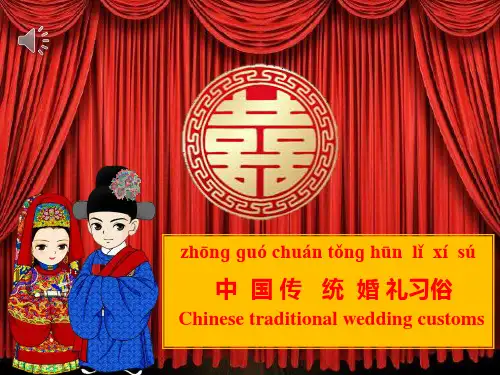
zhōnɡɡuó chuán tǒnɡhūn lǐ xí sú中国传统婚礼习俗Chinese traditional wedding customsIn more ancient writings for the word 婚姻, theformer has the 昏beside the radical 女. Thisimplies that the wedding ceremony is performedin the evening, which is deemed as a time offortune. Similarly, 姻has the samepronunciation as 因. According to a dictionaryof ancient Chinese characters, 因means"friendliness", "love" and "harmony", indicatingthe correct way of living for a married couple.hūn yīn婚姻Content 目录◆Preparation for the wedding◆Related Elements for wedding◆Procedures On the wedding day✓The "Hair Dressing" Ritual✓The "Capping" Ritual✓Wedding Procession✓Set off the red veil✓Cross-cupped wine✓The Wedding Banquets✓Disturb Bridal Chamber◆After the WeddingPreparation for the wedding Request for marrying the bride/Formal Proposal 提亲(tí qīn )Request for bride and groom’s birth dates/Birthdates 测生辰八字(cè shēnɡchén bá zì )Engagement/Bride price定亲(dìnɡqīn)Formal gifts for the bride’s family/betrothal gifts 送聘礼(sònɡpìn lǐ)Select the wedding date选日子(xuǎn rì zi)/请期(qǐnɡqī )Red colorRed is central to the wedding theme of China.It signifies love, joy and prosperity .e.g. wedding gown(新娘礼服)、shoes、package(包裹)、quilt(被子)、pillow(枕头)、door curtain (门帘)extra. Double Happiness (囍)It is usually printed on the invitation with the use of golden hot stamps. The symbol of Double Happiness is a declaration that the bride-to-be and the groom-to-be will be united. The symbol, which is composed of two standard Chinese characters used to signify "happiness", means that the couple and their families will now be "together".So 喜+喜=Types of musical instruments唢呐Suona,笛子Flute,板鼓Pan-ku,锣Gong,铙钹Cymbals,堂鼓Chinese opera drum 等等。
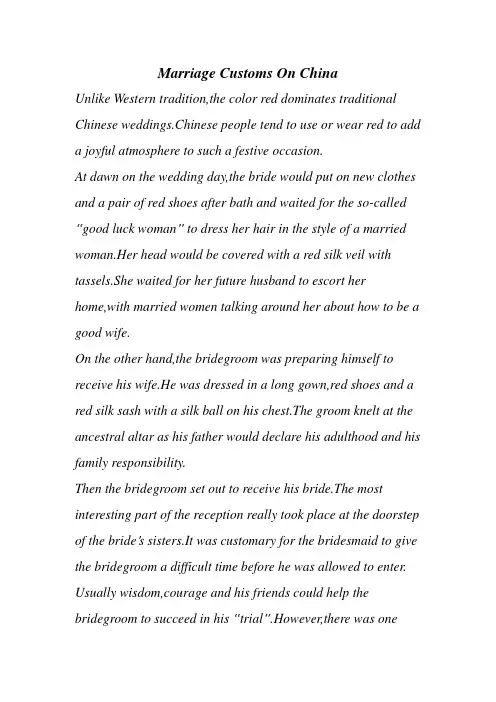
Marriage Customs On ChinaUnlike Western tradition,the color red dominates traditional Chinese weddings.Chinese people tend to use or wear red to add a joyful atmosphere to such a festive occasion.At dawn on the wedding day,the bride would put on new clothes and a pair of red shoes after bath and waited for the so-called “good luck woman” to dress her hair in the style of a married woman.Her head would be covered with a red silk veil with tassels.She waited for her future husband to escort her home,with married women talking around her about how to be a good wife.On the other hand,the bridegroom was preparing himself to receive his wife.He was dressed in a long gown,red shoes and a red silk sash with a silk ball on his chest.The groom knelt at the ancestral altar as his father would declare his adulthood and his family responsibility.Then the bridegroom set out to receive his bride.The most interesting part of the reception really took place at the doorstep of the bride’s sisters.It was customary for the bridesmaid to give the bridegroom a difficult time before he was allowed to enter. Usually wisdom,courage and his friends could help the bridegroom to succeed in his “trial”.However,there was onemore situation he had to negotiate with the bridesmaid and sisters of the bride—to distribute among them red packets containing money—in order to take his bride home.中国的婚姻习俗不像西方的传统,红色主宰中国传统婚礼。
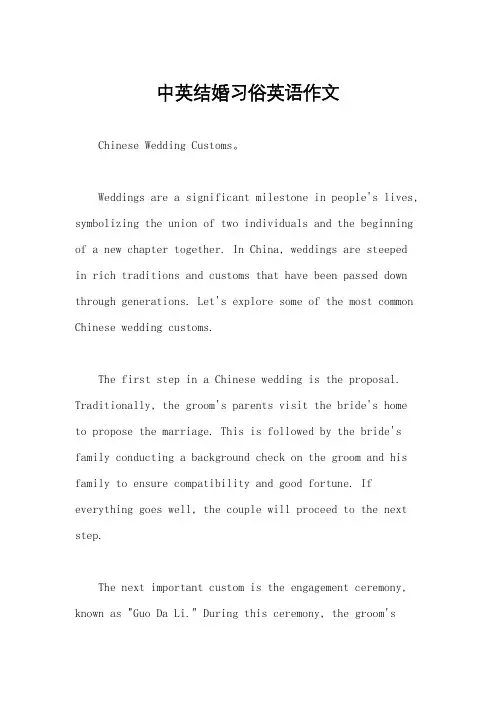
中英结婚习俗英语作文Chinese Wedding Customs。
Weddings are a significant milestone in people's lives, symbolizing the union of two individuals and the beginning of a new chapter together. In China, weddings are steepedin rich traditions and customs that have been passed down through generations. Let's explore some of the most common Chinese wedding customs.The first step in a Chinese wedding is the proposal. Traditionally, the groom's parents visit the bride's home to propose the marriage. This is followed by the bride's family conducting a background check on the groom and his family to ensure compatibility and good fortune. If everything goes well, the couple will proceed to the next step.The next important custom is the engagement ceremony, known as "Guo Da Li." During this ceremony, the groom'sfamily presents gifts to the bride's family, symbolizing their sincerity and respect. These gifts usually include items such as tea, jewelry, and red envelopes filled with money. The bride's family will also prepare gifts in return for the groom's family, signifying their acceptance of the proposal.As the wedding day approaches, the bride and groom will go through several rituals to prepare for their special day. One of these rituals is the hair combing ceremony. Thebride's hair is combed by a married woman from her family, symbolizing the transition from singlehood to married life. This ceremony is believed to bring good luck and fortune to the couple.On the wedding day, the groom will arrive at thebride's home to pick her up. However, before he can enter the bride's house, he must overcome several challenges set by the bridesmaids. These challenges are designed to test the groom's love and determination. Once he successfully completes the challenges, he is allowed to enter thebride's room and escort her to the wedding venue.The wedding ceremony itself is a blend of traditional and modern elements. The couple will exchange vows and rings, and the bride will wear a red wedding dress, symbolizing luck and happiness. Red is considered an auspicious color in Chinese culture. The couple will also pay respects to their ancestors by bowing to theirportraits and offering prayers. This is done to seek blessings for a harmonious and prosperous married life.After the wedding ceremony, a grand banquet is held to celebrate the union of the couple. Family and friendsgather to enjoy a sumptuous feast and offer their well wishes. The banquet is filled with joy, laughter, and heartfelt speeches. It is also customary for the guests to give red envelopes containing money to the newlyweds as a token of good luck and blessings.In recent years, some Chinese couples have also incorporated Western-style weddings into their celebrations. They may choose to have a white wedding gown, exchange wedding vows in a church, or have a wedding cake. Thisfusion of traditions reflects the changing times and the influence of globalization.Chinese wedding customs are deeply rooted in historyand culture, reflecting the values of filial piety, respect, and harmony. They serve as a reminder of the importance of family and the significance of marriage. While modern weddings may adapt to new trends, these customs continue to be cherished and passed down from generation to generation, ensuring the preservation of Chinese traditions and the celebration of love and unity.。
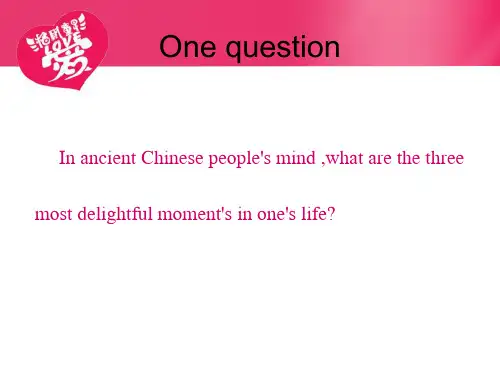
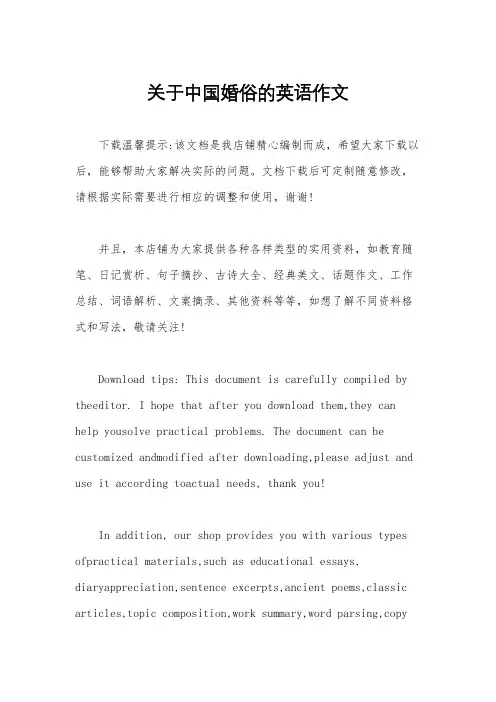
关于中国婚俗的英语作文下载温馨提示:该文档是我店铺精心编制而成,希望大家下载以后,能够帮助大家解决实际的问题。
文档下载后可定制随意修改,请根据实际需要进行相应的调整和使用,谢谢!并且,本店铺为大家提供各种各样类型的实用资料,如教育随笔、日记赏析、句子摘抄、古诗大全、经典美文、话题作文、工作总结、词语解析、文案摘录、其他资料等等,如想了解不同资料格式和写法,敬请关注!Download tips: This document is carefully compiled by theeditor. I hope that after you download them,they can help yousolve practical problems. The document can be customized andmodified after downloading,please adjust and use it according toactual needs, thank you!In addition, our shop provides you with various types ofpractical materials,such as educational essays, diaryappreciation,sentence excerpts,ancient poems,classic articles,topic composition,work summary,word parsing,copyexcerpts,other materials and so on,want to know different data formats andwriting methods,please pay attention!Chinese wedding customs are rich in tradition and symbolism. From the engagement to the wedding ceremony, every step is carefully planned and executed to ensure a memorable and auspicious occasion.In China, the engagement ceremony is an important event. It usually takes place several months before the weddingand involves the bride and groom's families coming together to exchange gifts and blessings. The groom's familypresents betrothal gifts to the bride's family, symbolizing their commitment to the marriage. This ceremony is often accompanied by a lavish banquet, where both families celebrate the union.On the wedding day, the bride and groom go through a series of rituals and customs. One popular tradition is the "gate-crashing" game, where the groom and his groomsmenmust complete various challenges set by the bridesmaids before they can enter the bride's room. This lightheartedtradition adds a fun and playful element to the wedding day.During the wedding ceremony, the bride and groom exchange vows and pay respects to their ancestors. Thebride wears a red wedding dress, symbolizing good luck and happiness, while the groom wears a black or blue suit. The couple also performs the tea ceremony, where they serve tea to their parents and elders as a sign of respect and gratitude.After the wedding ceremony, a grand wedding banquet is held to celebrate the union. This banquet is often a lavish affair, with multiple courses of delicious food and drinks. It is a time for the couple to thank their guests for their blessings and support.In addition to these customs, there are also regional variations in Chinese wedding traditions. For example, in some regions, the bride's family will hire a "good luck woman" to accompany the bride and groom throughout the wedding day, ensuring that everything goes smoothly. This person is believed to bring good luck and ward off evilspirits.Overall, Chinese wedding customs are a reflection of the country's rich cultural heritage and values. They emphasize the importance of family, respect, and tradition. Whether it's the engagement ceremony, the gate-crashing game, or the tea ceremony, each custom has its unique significance and adds to the joy and festivity of the occasion.In conclusion, Chinese wedding customs are steeped in tradition and symbolism. They are a celebration of love, family, and cultural heritage. From the engagement ceremony to the wedding banquet, each step is carefully planned and executed to ensure a memorable and auspicious occasion. Whether it's the exchange of gifts, the gate-crashing game, or the tea ceremony, these customs add a unique and meaningful touch to Chinese weddings.。
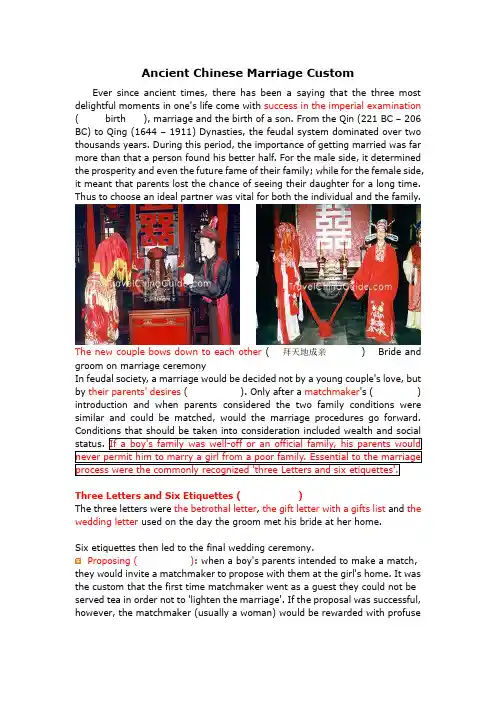
Ancient Chinese Marriage Custom Ever since ancient times, there has been a saying that the three most delightful moments in one's life come with success in the imperial examination ( birth ), marriage and the birth of a son. From the Qin (221 BC – 206 BC) to Qing (1644 – 1911) Dynasties, the feudal system dominated over two thousands years. During this period, the importance of getting married was far more than that a person found his better half. For the male side, it determined the prosperity and even the future fame of their family; while for the female side, it meant that parents lost the chance of seeing their daughter for a long time. Thus to choose an ideal partner was vital for both the individual and the family.The new couple bows down to each other ( 拜天地成亲) Bride and groom on marriage ceremonyIn feudal society, a marriage would be decided not by a young couple's love, but by their parents' desires ( ). Only after a matchmaker's ( ) introduction and when parents considered the two family conditions wereThree Letters and Six Etiquettes ( )The three letters were the betrothal letter, the gift letter with a gifts list and the wedding letter used on the day the groom met his bride at her home.Six etiquettes then led to the final wedding ceremony.Proposing ( ): when a boy's parents intended to make a match, they would invite a matchmaker to propose with them at the girl's home. It was the custom that the first time matchmaker went as a guest they could not be served tea in order not to 'lighten the marriage'. If the proposal was successful, however, the matchmaker (usually a woman) would be rewarded with profusegifts and feasts to show the two families' gratitude. Many unmarried young people could not see and were unfamiliar with each other till their wedding day. Birthday Matching ( ): after knowing the girl's full name and birthday, they would ask a fortune teller to predict whether that could match their son's and whether there would be a happy marriage. The Chinese zodiac would be surely taken into consideration.Presenting Betrothal Gifts ( ): if the match was predicted to be auspicious, the matchmaker would take gifts to the girl's parents and tell them that the process could continue.Presenting Wedding Gifts ( ): This was the grandest etiquette of the whole process of engagement. Prolific gifts were presented again to the girl's family, symbolizing respect and kindness towards the girl's family as well as the capability of providing agood life for the girl.Selecting the Wedding Date( ): the boy's familyasked the fortune-teller tochoose a date according to theastrological book when it wouldbe proper and propitious to holdthe wedding ceremony.Wedding Ceremony ( ):the wedding ceremony beganwith the groom and his partymeeting the bride in her home.Presenting Wedding GiftsBefore this day the bride'sdowry would have been sent to the boy's house. The dowry represented her social status and wealth, and would be displayed at the boy's house. The most common dowries included scissors like two butterflies never separating, rulers indicating acres of fields, and vases for peace and wealth.Before the meeting party's arrival, the bride would be helped by a respectable old woman to tie up her hair with colorful cotton threads. She would wear a red skirt as Chinese believed red foreshadowed delight. When the party( ) arrived, the bride, covered by a red head-kerchief, must cry with her mother to show her reluctance to leave home. She would be led or carried by her elder brother to the sedan. In the meeting party the groom would meet a series of difficulties intentionally set in his path. Only after coping with these could he pass to see his wife-to-be.place, there would be music and firecrackers.The bride would be led along the red carpet inOn the night of the wedding day, there was acustom in some places for relatives or friends).them dropped shyness and got familiar withQuestions:1、Translate those words in the red font into Chinese, then put the answers in the blank “( )”. As a Chinese, it must be easy. My purpose for this reading is to lead you to get and know closer to our traditional marriage culture.2、Please the Chinese customs in marriage according to words or sentences in1 ) 磕头——Kowtow / Kotow :在1816年,英国访问中国的大使宁死也不愿意向当时的中国皇帝磕头,英国人也不知道怎么解释这个词,所以就直接借用拿中文磕头的发音创造了一个词。
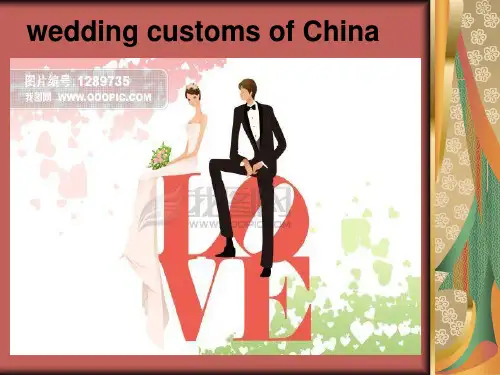
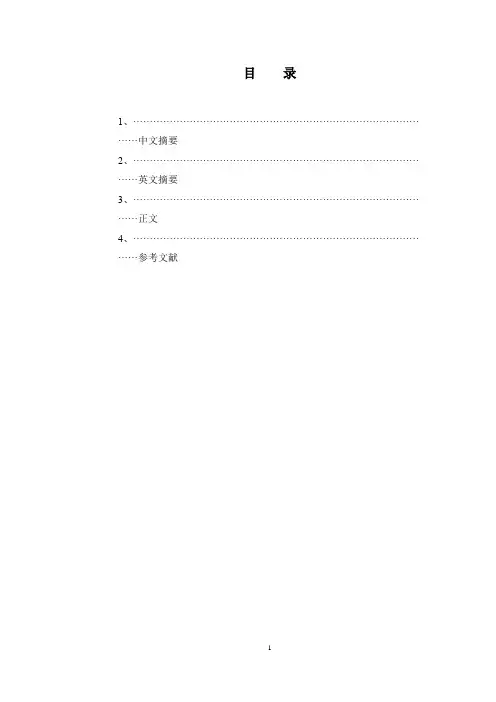
目录1、····························································································中文摘要2、····························································································英文摘要3、····························································································正文4、····························································································参考文献英文摘要:The traditional Chinese marriage customs contains rich cultural connotation. The traditional marriage reflects the level of difference, must be considered equal. We in Guanyun are no exception, not the words of a match-maker parents marriage is not accepted by the society and recognition. Now, Guanyun rural marriage custom than before the change and development, a lot of both traditional and modern.. The traditional is mainly manifested in the "gifts", "day", "press" send "real" legally married.中文摘要:中国传统的婚嫁习俗蕴含着丰富的文化内涵。
中国结婚礼仪风俗英语作文Chinese Wedding Customs and EtiquetteThe wedding ceremony in China is a momentous occasion filled with rich cultural traditions and deeply rooted customs. It marks the union of two individuals, not just as husband and wife, but also as part of two extended families. From the engagement to the wedding day and beyond, eachstep is laden with symbolism and rituals that reflect the unique beauty of Chinese culture.The engagement, known as "dinghun" in Chinese, is often preceded by the matching of horoscopes to ensure compatibility. Once the families agree, the groom's family presents gifts to the bride's family, symbolizing their acceptance of the match. This is followed by the betrothal ceremony, where the groom formally asks for the bride'shand in marriage.The wedding day itself is a grand affair, often held ina traditional setting adorned with red, the color of luck and happiness in Chinese culture. The bride and groom are dressed in elaborate costumes, the bride wearing a redqipao or cheongsam, while the groom wears a traditional Chinese suit or western attire.Before the ceremony, the bride undergoes a series of rituals known as "fenghuang guan" or "the phoenix crowns." This includes being dressed in her wedding attire, applying makeup, and having her hair styled. It is believed thatthis transforms the bride into a phoenix, the symbol of grace and beauty.The wedding ceremony typically begins with the bride's procession to the groom's home or the venue. She is escorted by family members and friends, often carrying a red umbrella to symbolize protection from evil spirits. Once the bride arrives, the ceremony begins with the exchange of vows and offerings of tea to the elders. This ritual is a show of respect and gratitude towards the parents of both bride and groom.After the ceremony, a festive banquet is held, where guests enjoy traditional Chinese cuisine and toast the newlyweds. This is a time for celebration, laughter, and joy as the couple begins their new journey together.Following the wedding, the bride and groom embark on a series of traditional customs, such as the "huimen" or "returning home" ceremony, where the couple visits the bride's parents' home to thank them for raising their daughter. Other customs include the "sancha" or "three tea" ceremony, where the couple visits the groom's relatives to introduce the bride and further strengthen the bonds between the two families.In conclusion, the wedding ceremony in China is a beautiful tapestry of rituals, traditions, and customs that bring together families, friends, and communities in celebration of love and the union of two souls. Each stepin the process is filled with meaning and symbolism, reflecting the rich history and culture of this ancient civilization.中国结婚礼仪风俗中国的婚礼仪式是一场盛大的庆典,充满了丰富的文化传统和根深蒂固的习俗。
关于中国婚俗的英语作文英文回答:I've always been fascinated by the rich and diverse tapestry of Chinese wedding customs. Growing up immersed in both Western and Eastern cultures, I've witnessed the beautiful blend of tradition and modernity that characterizes these rituals.Chinese weddings are a vivid tapestry of vibrant colors, elaborate ceremonies, and heartfelt emotions. They are not just about two individuals uniting but also about the merging of two families and the continuity of generations-old customs. From the grand celebrations to the intimate moments, every detail is meticulously planned to create an unforgettable experience.One of the most striking aspects of a Chinese wedding is the tea ceremony. This ritual, steeped in symbolism and respect, is a way to honor the elders and seek theirblessings. The couple serves tea to their parents and grandparents, expressing gratitude and acknowledging their guidance. As the tea is poured and sipped, it carries with it a silent promise of care and support.Another significant custom is the exchange of wedding gifts. Traditionally, the groom's family presents the bride's family with a dowry, symbolizing their commitment and providing her with financial security. The bride's family, in turn, reciprocates with a dowry of their own, showcasing their support for their daughter and her new life.The wedding day itself is a spectacle of joy and elegance. The bride, radiant in a traditional red gown, is escorted by her bridesmaids to the groom's house. As she crosses the threshold, she is greeted with firecrackers and loud music, meant to ward off evil spirits. The couple then proceeds to exchange vows before their guests, often under a beautifully decorated arch.After the ceremony, the newlyweds are taken to the banquet hall for a lavish reception. Toasts, speeches, and performances ensue, all designed to celebrate the couple's union and wish them well on their journey together. The food, a symbol of abundance and prosperity, is meticulously prepared and presented.As the evening progresses, the couple engages in traditional dances and games, adding a touch of playful fun to the occasion. The night concludes with a grand fireworks display, illuminating the sky with shimmering lights and leaving a lasting memory of the momentous occasion.Chinese wedding customs are not just rituals; they are a testament to the enduring power of tradition and the importance of family. They not only celebrate a couple's love but also connect them to their heritage and their ancestors. To me, they represent a beautiful blending of ancient wisdom and modern sensibilities, a timeless expression of love and commitment.中文回答:我一直沉醉于中国婚俗的丰富多彩和博大精深。
结婚古代传统流程Marriage is a significant life event in Chinese culture, and there are many traditional customs and rituals associated with the process. 结婚在中国传统文化中是一个重要的人生事件,并且有许多与这个过程相关的传统习俗和仪式。
The first step in the traditional Chinese marriage process is the proposal, where the groom's family formally proposes to the bride's family. 在中国传统的婚姻过程中,第一步是求婚,新郎家庭正式向新娘家庭提出求婚。
This is followed by the engagement, where both families exchange gifts and the bride receives her engagement ring. 然后是订婚仪式,双方家庭互赠礼物,新娘收到她的订婚戒指。
The wedding ceremony itself is a culmination of many traditions, including the tea ceremony, where the couple serves tea to their parents and elders as a sign of respect and gratitude. 婚礼仪式本身是许多传统的结晶,包括茶道仪式,在这个仪式上,新人向他们的父母和长辈敬茶,表示尊敬和感激之情。
Other traditions during the wedding ceremony may include the exchanging of vows, the sharing of a wedding banquet, and the unveiling of the bride's face. 婚礼仪式期间的其他传统可能包括交换誓言、分享婚宴以及揭开新娘的面纱。
中西婚礼差异英文版Differences Between Chinese Marriage Custom and Western Marriage CustomAbstractThere are many procedures in Chinese marriage custom. The book propriety and ceremony, which records earliest wedding ceremony, says that marriage includes six etiquettes, namely, proposing, asking the name, asking for fortune, sending betrothal presents to the girl's family, discussing the date of marriage and meeting the bride. In western marriage, there are four procedures. They are proposal, changing surnames, choosing the day and holding the wedding. As the different religions, cultural origins, marriage concepts and geographies, there are many differences existing in the two kinds of marriage customs. In Chinese marriage custom, the matchmaker functions almost all the time and youths have no right to choose and women are not on an equal footing with men. By contrast, in western marriage custom, the priest functions and the youths have legal right to choose whom they want to marry and men and women are equal. There also exist common things in the two sides. They have been maintained for thousands of years. But in recent years (especially after the founding of modern China), people have tended to discard some of the details and advocate simplifiedmarriage procedures and wedding ceremonies.Key Words:Marriage custom; differences; reasons摘要中国婚俗有着许多的仪式。
Differences Between Chinese Marriage Custom and Western Marriage Custom中西方婚俗的差异AbstractThere are many procedures in Chinese marriage custom. The book propriety and ceremony, which records earliest wedding ceremony, says that marriage includes six etiquettes, namely, proposing, asking the name, asking for fortune, sending betrothal presents to the girl's family, discussing th e date of marriage and meeting the bride. In western marriage, there are four procedures. They are proposal, changing surnames, choosing the day and holding the wedding. As the different reli gions, cultural origins, marriage concepts and geographies, there are many differences existing in the two kinds of marriage customs. In Chinese marriage custom, the matchmaker functions almost all the time and youths have no right to choose and women are not on an equal footing with m en. By contrast, in western marriage custom, the priest functions and the youths have legal right to choose whom they want to marry and men and women are equal. There also exist common t hings in the two sides. They have been maintained for thousands of years. But in recent years (e specially after the founding of modern China), people have tended to discard some of the details and advocate simplified marriage procedures and wedding ceremonies.IntroductionMarriage is formed in a long historical evolution of the marriage custom in a nation. It is the reg ularity of the activities that restrains people's awareness of marriage and marriage. Marriage custo m’s binding does not depend on the law, and it can not rely on science tests neither, but on the force of habit, traditional culture and national psychology. During the development of human hist ory, the institution of marriage and family system has experienced different processes of developm ent. Human have experienced group marriage, the dual system of marriage and individual marriag e system (monogamy).As a union of a man and a woman and a family formation stage, marriage includes not only mar riage, but also the preparation phase for the marriage and the performance stage after the festivi ties. It runs through the whole process of life. These customs, as a national symbol and cultural development, plays a very important role in ethnic studies and the history of mankind.China is a country with an ancient civilization and a long history, and many customs. Among so many customs, there is a particular marriage custom. This custom goes through various and long stages of development from ancient simple wedding ceremony to later complex ceremony, from fe udal marriage custom to the modern free marriage custom. During these courses, people’s ideas a re progressing, though we can not say that their ideas are up to th e top of mankind’s ideas in al l over the world at all over the time because there are still backward ideas existing in many plac es, in many people’s mind and they maybe will still exist for a long time. However, they are up t o the top of mankind’s ideas i n a certain stage of the uninterrupted development of ideas. Greek civilization is the base of western culture. Britain plays an important role in western history and western culture, and of course marriage custom.Comparing with each other, they are different in many aspects such as in right aspect and in fre edom aspect and there are many reasons that result in these differences such as cultural reasonand geographical reason.I. Chinese Marriage CustomLike other folk, marriage custom has the same development and evolving process. In the early da ys of humanity, the human relationship in a very long period of time still carried the irregular rela tions like the animal world. There was no marriage at all, if suggest some, the only "arbitrary ma rriage."In China, marriage has gone through for a long time. As a most grand etiquette, it has always b een a high degree of attention. To control the marriage, the family and the whole society, since t he beginning of Zhou Dynasty, Chinese marriage should comply with six procedures, which is the so-called "six etiquettes." And Later in Tang and Ming Dynasty in China, marriage also complied with the "six etiquettes". As time goes by, although many wedding customs experienced various c hanges "Six etiquettes" as the basic pattern has not changed much. It is still essential and core i n marriage custom.Marriage has changed much today, but in many places, there still remains traditional marriage cus tom.In feudal society, a marriage would be decided not by the youths’ love, b ut by their parents' desi res. Only after a matchmaker's introduction and when parents considered the two family condition s were similar and could be matched, would the marriage procedures went forward. Conditions th at should be taken into consideration included wealth and social status. If a boy's family was well -off or an official family, his parents would never permit him to marry a girl from a poor family. Essential to the marriage process were the commonly recognized 'three Letters and six etiquettes'. The three letters were the betrothal letter, the gift letter with a gifts list and the wedding letter used on the day the bridegroom met his bride at her home.The book propriety and ceremony, which records earliest wedding ceremony, says that marriage, usually, involves six necessary procedures, namely, proposing, asking the name, asking for fortune, sending betrothal present to girl's family, discussing date of marriage and meeting the bride. A. Proposing:Proposing is the first etiquette in marriage and is the first meet between the members in the two families. Thus, it is very important. Using a common expression, it is making an offer of marriag e to another family on behalf of the son or daughter.If the parents thought that the girl could be the daughter-in-law in old times, they would ask a matchmaker for sending the gifts and bring the son and the girl together. If the girl’s parents als o agreed on the marriage, they would accept the gifts. People usually used a wild goose when se nding the gifts. Because the wild gooses could fly to the south or the north according to the sea sons and they would never change it which implied the woman would be punctual and also beca use when the wild gooses flied they were in a row and when they stopped they were in a line w hich implied that woman should comply with the marriage rules and arrange in order that one sh ould not breach it.B. Asking the NameIt aims to ask for girl’s name and pray.In ancient times the girl’s name would not be known by other people until th e girl was in an ageof marriage.First, one must have the matchmaker and inform of the man’s family through a card. And the m an’s family would lastly receipt for postal remittance. Thus it can be seen that “asking the name”not only meant that the man’s family wanted to know the girl’s name, but also wrote down the woman’s birthday and Eight-characters (in four pairs denoting the time, date, month and year of a person’s birth, each pair consisting of one Heavenly Stem and one Earthly Branch, used in fortu ne-telling). If the birthday and Eight-characters were not harm the man, the man’s family would l astly receipt for postal remittance. Sometimes the woman’s parents also wrote down the official p osition of the woman’s great-grandpa, grandpa and father and the dowry that could be supplied. What’s interesting is that during this progress it was the matchmaker that functioned, not the ma n’s family or the woman’s family. Matchmaker was also important in the other procedures. In trad itional Chinese marriage, peop le believed “behest of the parents and proposal of a matchmaker”. That’s why many marriages in the past were arranged by parents and matchmakers. Matchmaker’s proposal was the marriage’s valid basis in Tang dynasty.It has been simplified today. Many marriage does not need this process.C. Asking for FortuneAfter asking the name, the bridegroom’s side had got the woman’s birthday and Eight-Characters and they went to consult a fortune-teller then which was called “asking for fortune”. It included t wo aspects of contents. One was consult the female virtues. Ancient people regarded female virtu es as the most important one in the gospel of three obedience that were obedience to one’s fath er before marriage, to one’s husband after marriage, and to one’s son after one’s husband’s deat h and four virtues that was morality, proper speech, modest manner, and diligent work for a wo man according to Confucian ethics.Zhong lichun, Zhuge Liang’s wife (Zhuge Liang was a statesman and strategist in the period of th e Three Kingdoms, now a symbol of wisdom in Chinese folklore) was famous for her ugliness, wis dom and high female virtues. A man in old times always had many wives. In order to solidifying and stead in the family, people paid much attention to female virtues. Hence there was the saw “Marry wife is marrying virtues and take a concubine is marrying appearance”.The other one was consult good or bad luck. If they were not fit for each other in Eight-Charact ers according to the birthday and what’s more, the woman woul d harm the man, the result was t hat this marriage would not be held and would be cancelled. If the result was fit for each other and moreover the woman would make the man prosperous, the man’s side would inform the wo man’s side through the matchmaker and s end the betrothal gifts and exchange cards. Thus the m arriage was actually decided to be held.D. Sending Betrothal Presents to the Girl’s FamilyThe book propriety and ceremony wrote by the scholars in Han dynasty regards it as sending mo ney. If there is no receipt of gifts, there is no marriage. Hence whether receipt the gifts or not i s the implication of the agreement of the marriage by the woman’s side.The significance of it includes two aspects of meaning. One is the thanks for the woman’s parent s bec ause the parents feed up her. The other is help the woman’s family prepare for dowry.E. Discussing the Date of MarriageIn the past, the bridegroom’s side decided the lucky day and sent the matchmaker to inform of t he woman’s family. People paid much atte ntion to the marriage time. They usually had a person l ooked at the almanac or asked for fortune. They liked having marriage in spring or autumn beca use spring was the time that everything comes back to life and time when spring was changing i nto summer and was favor to pregnant with new life; autumn was the season of harvest. After t he labor for a year, people had enough money to hold the marriage.Nowadays, it is also an important event. People pay many attentions to it.F. Meeting the BrideThe marriage is finally held after the five procedures. In the past, the bridegroom wore wedding suit, riding on a horse, and guided the bridal sedan chair to marry the bride on the day. And the bride wore a red cheongsam waiting for the bridegroom. Now, the bridegroom wares western sui t, and the bride wares wedding dress and usually in a car.II. Western Marriage CustomIn the middle ages children were married at a young age. Girls were as young as 12 when they got married, and boys as young as 14. The arrangement of the marriage was based on monetary worth. The family of the girl who was to be married gave a dowry, or donation, to the boy she was to marry. The dowry went with her when the marriage was held and stayed with the boy f orever after the marriage. After the marriage was arranged, a wedding notice was posted on the door of the church. The notice was put up to ensure that there were no grounds for prohibiting t he marriage. The notice stated who was to be married, and if anyone knew any reasons that the two could not marry, they were to come forward with the reason. If the reason was a valid one the wedding would be prohibited.There were many reasons for prohibiting a marriage. One reason was consanguinity, if the two w ere too closely related. If the boy or the girl had taken a monastic or religious vow, the marriage was also prohibited. Sometimes widows or widowers took vows of celibacy on the death of their spouse, and later regretted doing so when they could not remarry. Other reasons which also pro hibited marriage, but were not grounds for a divorce, were rape, adultery, and incest. A couple c ould not be married during a time of fasting, such as lent or advent. Nor could a couple be marr ied by someone who had killed someone.In the middle ages there were few reasons the wedding could be dissolved. One reason was if ei ther the man or woman were not of legal age, 12 for girls and 14 for boys. If the husband or w ife had previously made a religious or monastic vow or were not Christian, the marriage would be dissolved. The last reason a marriage could end was if the woman, not the man, was incapable of sexual relations.A. ProposalWhen the prospective groom had obtained his father’s consent to marry, a formal marriage propo sal had to be made. The prospective groom did not propose in person but sent his friends or me mbers of his family to represent his interest to the prospective bride and her family. If they saw a blind man, a monk or a pregnant woman during their journey, it was believed that the proposal would not be accepted as these signs were thought to bring bad luck. If, however, they saw na nny goats, pigeons or wolves, this was a good omen which would bring good fortune to the marr iage.During Medieval times in western countries, the man proposed by leaving a hawthorn branch at t he door of his beloved on the first of May. By leaving the branch at the door she accepted his p roposal. She made known her refusal by replacing the hawthorn branch with a cauliflower.B. Changing SurnamesIt was thought unlucky for a woman to marry a man whose surname began with the same letter as hers. The sentiment was summarized in the following thyme:To change the name and not the letter is to change for the worst and not the betterThe bride should not practice writing her new name before the wedding. This was thought to bri ng bad luck by tempting fate.C. Choosing the DayAlthough most weddings now take place on a Saturday, it was considered unlucky in the past. Fri days were also considered unlucky particularly Friday the 13th. The famous old rhyme advised a wedding in the first half of the week:Monday for wealthTuesday for healthWednesday the best day of allThursday for lossesFriday for crosses (= funerals)Saturday for no luck at allAdvice on which month to marry in was given by the following rhyme:Married when the year is new, he'll love, kind and true.When February birds do mate, you neither wed nor dread your fate.If you wed when March winds blow, joy and sorrow both you'll know.Marry in April when you can, Joy for Maiden and for Man.Marry in the month of May, and you'll surely rue the day.Marry when June roses grow, over land and sea you'll go.Those who in July do wed, must labor for their daily bred.Whoever wed in August be, many a change is sure to seeMarry in September's shrine, your living will be rich and fine.If in October you do marry, love will come but riches tarry.If you wed in bleak November, only joys will come, remember.When December snows fall fast, marry and true love will last.Marry in May and you'll live to rue the dayMay had been considered an unlucky month to marry in for a number of reasons. In Pagan times the Feast of the Dead and the festival of the goddess of chastity both occurred in May. The adv ice was taken more seriously in Victorian times than it is today. In most Churches the end of Apr il was a busy time for weddings as couples wanted to avoid being married in May. Queen Victori a was thought to have forbidden her children from marrying in May.June was considered to be a lucky month to marry in, because it was named after Juno, the Roman goddess of love and marriage.The summer as a whole was considered a good time to marry and this was partly to do with the sun's association with fertility. In Scotland one popular custom was for the bride to "walk with t he sun" to bring her good. She would walk from east to west on the south side of the church a nd then continue walking around the church three times.D. Holding the WeddingThe wedding ceremony was finally held.The church ceremony in the middle ages took place outside the church door before entering the church for a nuptial mass. During the ceremony in front of the church doors the man stood on t he right side and the woman stood on the left side, facing the door of the churc h. “The reason was that she was formed out of a rib in the left side of Adam.” The priest began by asking if an yone knew of any reason the couple should not be married. He also asked this of the man and woman so they might confess any reasons for prohibiting their marriage.The ceremony proceeded with the priest saying, “N (amen) wilt though have this woman to thy wedded wife, wilt the love her, and honor her, keep her and guard her, in health and in sickness, as a husband should a wife, and forsaking all others on account of her, keep thee only unto he r, so long as ye both shall live?” Then the priest, changing the wording of “as a husband should a wife”, asked the same of the woman. Both the man and the woman should answer by saying”I will.” At this time the woman was given by her father. The wedding continued with the saying of vows. Both the man and the woman, with the exception of the words wife and husband, said,“I N. take thee N. to my wedded wife, to have and to hold from this day forward, for bette r, fo r worse, for richer, for poorer, in sickness, and in health, till death do us part, if the holy church will ordain it. And thereto I plight thee my troth.” At this time the ring exchange occurred. They bowed their heads and the priest gave them a blessing. As husband and wife they entered the church, where they knelt before the altar. At the altar the priest gave a prayer and a blessing, th us ending the marriage ceremony.If the bridegroom and bride did not belong to England of Church, they must use the second marr iage form, according to the law, that was go to the marriage registrant to hold a secular marriag e ceremony.III. DifferencesIt is clear that Chinese marriage custom and western marriage custom differ from each other in many aspects. In Chinese marriage custom the matchmaker has many functions and youths have no right to choose and women are not on an equal footing with men. By contrast, in western ma rriage custom, the priest has functions and the youths, particular the man, have legal right to ch oose whom they wanted to marry and men and women are equal.A. Different Marriage MediaMatchmaker and priest are different. Matchmaker has many functions. Almost in every process in marriage in old times, the matchmaker would attend. First, it was the matchmaker that introduced a man to a woman or a woman to a man, most the former. If matchmaker did not introduce th em to each other, they would not know about each other for ever. If some accident event happe ned, that is they knew each other not through the matchmaker, they would be called “committingadultery with each other “or “a thief if a man and a whore if a woman”. Second, the other proc edures after introduction in marriage were also done by the matchmaker.There were three conditions in marriage i n old China that were the matchmaker’s proposals, six g ifts and meet, people kept honoring the ancestors as the center in these three conditions. The re gulation of listening to matchmaker’s proposals was the rule that people must abide by. The reas on was not only the function the matchmaker had in society, but also the meaning that the matc hmaker had in later generation reproduction.In modern times, matchmaker still has some of above functions such as the function of introducti on.Priest does not always function. It is his duty only when he hosts the wedding ceremony. It was not the priest who introduces the man to the woman or the woman to the man.In Christian’s opinions, wedding ceremony is considered as an important way to get god’s save an d wedding ceremony is a very important part of marriage. Priest plays an essential role in it. And marriage is not valid, unless the ceremony is hosted by priest. There are three conditions in mar riage too. First, there should be some correct things that is used when go to church; second, cor rect means to go to church especially correct reading prayer book; third, correct motive to go to church which emphasizes action by church’s order. It can be seen that church is important in wes tern people’s eyes, so the priest is n ecessary when holding a marriage. And marriage is tinged wi th mystery because of these conditions.B. Freedom: Free or NotIn old China, people looked at the country and society as the standard, thus, “behest of parents”played an absolute important role in marriage. It was the principles of heaven and earth—right a nd proper when parents dealt with the son's or daughter's marriage only by their own opinions. Marriage in China was arranged by family. “Behest of parents and proposals of matchmaker” deci ded everything about marriage. Usually the husband and the wife did not meet each other before getting married. They did not know what their husband or wife liked. Even sometimes they did not know the names of each. If they did not agree the marriage, it was no use because the righ t of decision belonged to their parents. The marriage would still be held.The youths are not free when chose the lover in some places even today.Marriage marks the beginning of complete independence from the parents. According to the Englis h law, no one was allowed to get married under the age of sixteen. Marriage between the age o f sixteen and eighteen must have the parents’ consent. But when the girl was over eighteen, she was free to choose her love. Youths in Britain were relatively free. In Britain, church pointed out “agreement principle” which pointed out that the marriage was valid only when the two persons involved in marriage expressed freely and openly in front of at least two chief witness at wedding ceremony; the marriage was not valid when there existing misunderstanding or force in marriage. Under this “agreement principle”, the father should listen to the daughter’s suggestion, and the f ather should not force the daughter to marry with the man whom she did not want to marry. Th us, it can be seen from this point that, one’s willing was superior to anything.C. Right: Equal or NotChinese men were hold up as “sky” and women were considered as “earth” in old times. Sky wassuperior to earth in old people’s eyes. And women m ust comply with three obedience and four v irtues. But man could have a wife and many concubines. In north of China in some places, husba nd and wife are still unequal.The Bible says that husband should respect wife because both of them are blessed by God. And i t emphasizes that the relations between husband and wife should include duty.D. Different Purposes of MarriageThe main purpose of getting marriage in China is to continue the male offspring. The so-called “t here are three forms of filial impiety, o f which the most serious is to have no heir” reflects the i mportance to serve ancestors. And the filial piety is traditional virtues.In western countries, they are influenced deeply by religion, especially the Christianity. They think that it is the God who has created marriage. There are three purposes of the marriage created by God. First, the couple is lifelong companion with each other; they serve God together. Then g et married, start career and produce an heir to carry on the pious descendants. The final purpose is carrying on the pious descendants to serve to God. So they do not stress the blood relationsh ip. They can remedy the defect of non-child by adopting other children.IV. Reasons for the Differences AboveA. ReligionsAmong all the religion by which people seek to worship, Christianity is by far the most influential in the west. Every phase of man’s life is touched by this religion, so much so that it has become part and parcel of western culture. British dominant religious belief is Christian faith; or rather th e U.K. is a country of Christianity.Bishop ordered marriage law as the fourth chapter in 1234. After issuing the law, it was carried o n under the strong church control. In 1917, the marriage law referred: wedding ceremony should be held by priest or at least two witness; the willing should be true and not be forced.Most Chinese people believes Buddhism which advocates “why and because relationship”. In this p oint of view, sky is the reason, and earth is the result; parents are the reason, and sons or daug hters are the result; husband is the reason, and wife is the result.B. Cultural OriginsTraditional Chinese traditional marriage custom was characterized by a distinctive patriarchal clan s ystem. “Three obedience and four virtues” dec ided that women should become an appendage to t he men and be subordinated to the family interest. It was also characterized by strong feudal pol itical color. Marriage sometimes was a kind of ways to ally in political. The policy of cementing fri endly relations through political marriages was a typical example in history. The traditional marriag e custom was influenced deeply by Confucianism.There sill exists differences between males and females in marriage custom today. This phenomen on is also caused by the traditional Chinese culture.Western marriage custom is influenced deeply by religion, however, which emphasizes both men a nd women are God’s sons and daughters, so they are equal unlike Chinese who pay more attenti ons to boys. Western people consider girls are also the fruit of love.C. Marriage ConceptsChinese people once thought that marriage was a kind of ways to increase families, offspring and protect and enhance family’s reputation and position. Marriage would add a girl of a clan other t han one’s own, so marriage was looked as the important event of family but not one’s own event. The love between the man and the woman was not the first condition of marriage. Today the m arriage concepts have not changed much especially in some backward places. The aim of getting marriage for them is till to increase families, offspring and protect and enhance family’s reputation and position.In western countries, marriage is the love’s home to return to. The aim of marriage is to make t he woman and the man live together all the life. It is the personal affair. They have no duty to i ncrease family, offspring and protect and enhance family’s reputation and position. The marriage j ust make them live together. Thus those westerners stress feeling not the family’s inte rest or rep utation when they are choosing lover.D. GeographiesBritain is over one thousand kilometers from south to north. Its coastline runs about ten thousand kilometers, making it one of the countries with the longest coastlines in the world. In Britain no place is over one hundred and twenty kilometers from the sea. During the fight with the sea, Brit ish people feel the strong force of the nature that is difficult to control. Thus they believed God. They think God is omnipotent and they respect God very much.China’s geography is extremely varied and complex, including mountains, plateaus, plains, grasslan ds, basins, hills, islands, desert, glaciers, and frozen earth. Mountain areas cover about two-thirds of the total land area. This geography decides that Chinese people live mainly by farming and liv e in groups, and later formed the patriarchal clan system with rigidly stratified. This makes Chines e people respect the person that exists in objective reality that is the ancestors that created tribe and saved the country.Chinese people respect ancestors and western people respect God that lead the spirit world in Chi na into ethics that take the main position and in western religion take the main position. Thus it causes marriage differences.ConclusionMarriage custom in both China and western countries has gone through for a long time. As a mo st grand thing in people’s life, it has always attracted a high degree of attention.As time goes by, although many wedding customs have experienced various changes, as the basic pattern, “six etiquettes” in China has not changed much. That’s to say proposing, asking the na me, asking for fortune, sending betrothal presents to the girl’s family, discussing the date of marri age and meeting the bride are still essential and core in marriage custom.In western countries, a valid marriage should experience proposal, surnames, choosing the day an d holding the wedding.There are four differences between the two kinds of marriage custom. Firstly, the marriage media are different. Marriage media in China is matchmaker, but priest in western countries. Secondly, youths have no free right to choose their lover in China, but in western countries people are muc h freer on this point. Thirdly, westerners are equal than Chinese in marriage. Fourthly, the main purpose of getting marriage in China is to continue the male offspring. However in western count。